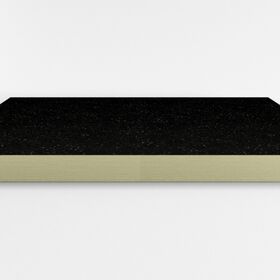Polyisocyanurate panels are used as a component of thermal insulation systems. They provide efficient thermal insulation as compared to other construction materials such as mineral wool or foamed polystyrene. They allow for cost-effective, long-lasting, and safe use of a house or an apartment.
Polyisocyanurate panels are used to insulate:
- foundations;
- walls;
- exterior walls;
- ceilings;
- terraces and balconies;
- flat roofs, and pitched roofs.
PIR term-BT construction
Panel is covered with with bitumen lining (BT). The core of the panel is made of rigid polyisocyanurate foam (PIR) with very good insulating and fire-resistance properties.
Joint types
Milling can be performed as follows:
| FIT | LAP | TAG |
| Straight edges | Overlap edges | Tounge and Groove |
 |
 |
 |
Technical data
| Parameter | Value | ||||||||||||
| Apparent density of core | kg/m3 | 30 (+6/-2) | |||||||||||
| Panel thickness | mm | 20 | 40 | 50 | 60 | 80 | 100 | 120 | 150 | 180 | 200 | 220 | 250 |
| Declared heat conductivity coefficient λD | W/m*K | 0.026 | 0.025 | 0.024 | |||||||||
| Thermal resistance RD | m2*K/W | 0.75 | 1.50 | 1.90 | 2.30 | 3.20 | 4.00 | 5.00 | 6.25 | 7.50 | 8.30 | 9.15 | 10.40 |
| Heat transfer coefficient U | W/m2*K | 1.30 | 0.65 | 0.52 | 0.43 | 0.31 | 0.25 | 0.20 | 0.16 | 0.13 | 0.12 | 0.11 | 0.10 |
| Fire reaction classification | F | ||||||||||||
| Compressive strength | ≥ 120 kPa | ||||||||||||












